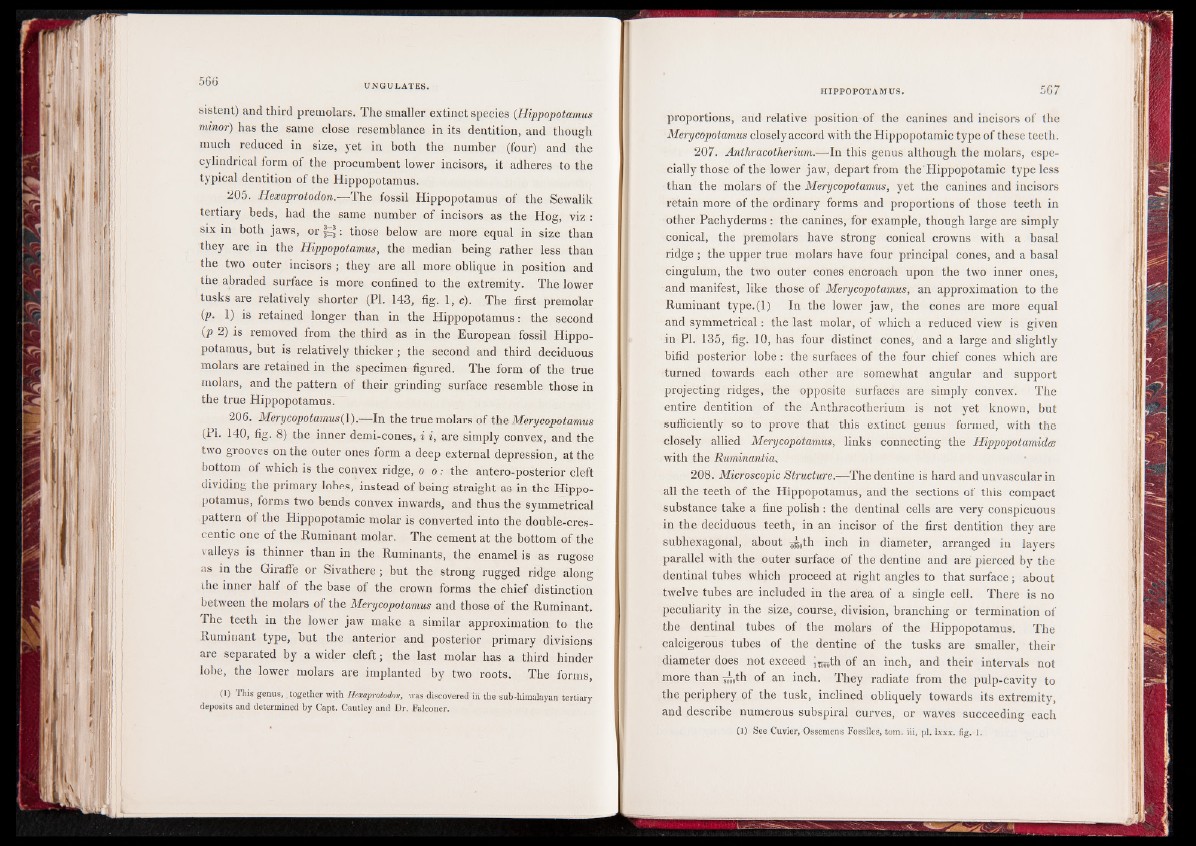
566
sistent) and third pretnolars. The smaller extinct species {Hippopotamus
minor) has the same close resemblance in its dentition, and though
much reduced in size, yet in both the number (four) and the
cylindrical form of the procumbent lower incisors, it adheres to the
typical dentition of the Hippopotamus.
205. Hexaprotodon.— The fossil Hippopotamus of the Sewalik
tertiary beds, had the same number of incisors as the Hog, viz :
six in both jaws, or ~3: those below are more equal in size than
they are in the Hippopotamus, the median being rather less than
the two outer incisors ; they are all more oblique in position and
the abraded surface is more confined to the extremity. The lower
tusks are relatively shorter (PI. 143, fig. 1, c). The first premolar
{p. 1) is retained longer than in the Hippopotamus: the second
{p 2) is removed from the third as in the European fossil Hippopotamus,
but is relatively thicker; the second and third deciduous
molars are retained in the specimen figured. The form of the true
molars, and the pattern of their grinding surface resemble those in
the true Hippopotamus.
206. Merycopotamus{\).—In the true molars of the Merycopotamus
(PI. 140, fig. 8) the inner demi-cones, i i, are simply convex, and the
two grooves on the outer ones form a deep external depression, at the
bottom of which is the convex ridge, o o: the antero-posterior cleft
dividing the primary lobes, instead of being straight as in the Hippopotamus,
forms two bends convex inwards, and thus the symmetrical
pattern of the Hippopotamic molar is converted into the double-crescentic
one of the Ruminant molar. The cement at the bottom of the
valleys is thinner than in the Ruminants, the enamel is as rugose
as in the Giraffe or Sivathere; hut the strong rugged ridge along
the inner half of the base of the crown forms the chief distinction
between the molars of the Merycopotamus and those of the Ruminant.
The teeth in the lower jaw make a similar approximation to the
Ruminant type, but the anterior and posterior primary divisions
are separated by a wider cleft; the last molar has a third hinder
lobe, the lower molars are implanted by two roots. The forms,
(1) This genus,, together with Hexaprotodon, was discovered in the sub-himalayan tertiary
deposits and determined by Capt. Cautley and Dr. Falconer.
proportions, and relative position of the canines and incisors of the
Merycopotamus closelyaccord writh the Hippopotamic type of these teeth.
207. Anthracotherium0j-ln this genus although the molars, especially
those of the lower jaw, depart from the Hippopotamic type less
than the molars of the Merycopotamus, yet the canines and incisors
retain more of the ordinary forms and proportions of those teeth in
other Pachyderms : the canines, for example, though large are simply
conical, the premolars have strong conical crowns with a basal
ridge ; the upper true molars have four principal cones, and a basal
cingulum, the two outer cones encroach upon the two inner ones,
and manifest, like those of Merycopotamus, an approximation to the
Ruminant type.(l) In the lower jaw, the cones are more equal
and symmetrical: the last molar, of which a reduced view is given
in PI. 135, fig. 10, has four distinct cones', and a large and slightly
bifid posterior lobe : the surfaces of the four chief cones which are
turned towards each other are somewhat angular and support
projecting ridges, the opposite surfaces are simply convex. The
entire dentition of the Anthracotherium is not yet known, but
sufficiently so to prove that this extinct genus formed, with the
closely allied Merycopotamus, links connecting the Hippopotamidas
with the Ruminantia.
208. Microscopic Structure.—The dentine is hard and unvascular in
all the teeth of the Hippopotamus, and the sections of this compact
substance take a fine polish: the dentinal cells are very conspicuous
in the deciduous teeth, in an incisor of the first dentition they are
subhexagonal, about ^„th inch in diameter, arranged in layers
parallel with the outer surface of the dentine and are pierced by the
dentinal tubes which proceed at right angles to that surface ; about
twelve tubes are included in the area of a single cell. There is no
peculiarity in the size, course, division, branching or termination of
the dentinal tubes of the molars of the Hippopotamus. The
calcigerous tubes of the dentine of the tusks are smaller, their
diameter does not exceed lW)th of an inch, and their intervals not
more than ®„th of an inch. They radiate from the pulp-cavity to
the periphery of the tusk, inclined obliquely towards its extremity,
and describe numerous subspiral curves, or waves succeeding each
(1) See Cuvier, Ossemens Fossiles, tom. iii, p], lxxx. fig. 1.